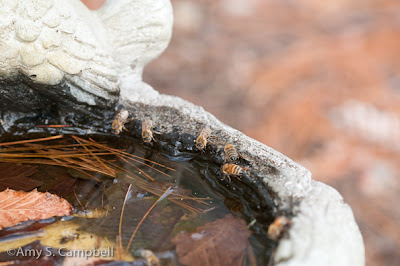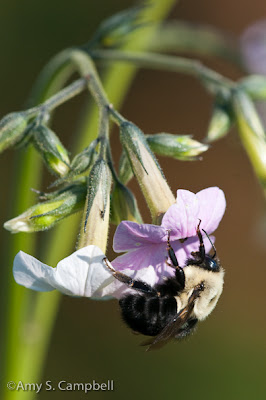 |
| Do Not Disturb! Honeybees at work extracting honey. |
Yesterday, a tropical-esque day for mid-November, I brought outside a frame of mostly capped honey and placed it on the ground under an oak tree. The honey was still liquid for the most part even after more than a year in the freezer - I checked this in the process of scratching the cappings, the wax coating with which bees seal the honey-filled cells, so the bees could access their favorite food. The frame had actually been in a very warm place for about a month and just by gently running a comb-like pronged kitchen implement over the surface started some sweet drippings!
Why, oh why did I think that this was a good idea? Sometimes I don't know what comes over me when I get into the bee mood. It has been way too warm for too long this fall. Almost counterintuitively, the warm temperatures spur the bees to eat more than if it is colder, hence they are working down their winter stores. My idea was to feed them back some food and give them something to do on this pretty day. Hardly anything is still blooming, although there were some foragers on the Nicotiana. With three hives and eeny meeny miney not an option, the only way to do this was to put the frame outside and let scouts from all three hives find it and spread the news.
It didn't take long. In five minutes one scout had landed on the back side of the frame and I watched as she gave it the first taste test with her tongue. Must have passed the test. More bees collected in very short order. Even as the weather deteriorated during the day, the bees were at work, slurping - if they slurp - up the honey. Lots and lots of bees. On both sides of the frame which was leaning against the trunk of an oak tree about 75 feet from the hive. At about 4pm, under ever grayer and darker skies, they were still at it. At 415pm, I started to wonder if they would go home or camp out on the frame, especially on the sheltered side facing the tree trunk. This I would not let happen, I decided, and just in case, I pulled out of the garage and had ready a hive body box, makeshift top and cardboard bottom, and a stone to weigh the top down against inquisitive skunks. I checked them again at 430 and not discerning if they were starting to commute back to the hives but having the plan ready to implement, went back to my whatevers.
At 630pm, with a flashlight, I went outside to check. It was raining. The bar was closed. All the good little bees had gone home. What a dummy I was to doubt their instinct! In their place there were a number of moths feeding on the honey. They kind of had that guilty look of being caught in a dishonest act. Well, not really, but they did appear to be crouching.
Today, not quite as warm but otherwise a copy of yesterday's weather, I replaced the frame. But I was only doing what they were telling me to do because even at 730am, bees were flying around the area under the oak tree, looking. Where is the honey? So I brought out the frame again which still had a couple of pounds of honey in the cells. This afternoon at 4pm, their day was done, and most all the honey had been extracted. Here is closer photo of the action on the frame....
 |
| Busy bees at the honey bar |
I love how their wings, folded back along their abdomens, are shiny and shimmery in the light. I wonder if they work tightly packed together like this as a heat-saving technique. Standing room only....The cells on the inside of the L-shape of the cluster are empty. The ones to the left were not scratched as well and some in this photo are still full. When I picked up the frame this afternoon, this section had been cleaned out too, all but the ones near the top of the frame. Maybe tomorrow.... weather permitting....Or maybe this was their snack at season's end, or rather, their Thanksgiving feast.

















































